- Products
- New Products
- Featured Products
- Color and Print Themes
- Blood Pressure Measurement
- NIBP / Vital Sign Monitors
- Digital Aneroid Sphygmomanometers
- Palm Aneroid Sphygmomanometers
- Pocket Aneroid Sphygmomanometers
- Pro's Combo Sphygmomanometers
- Multicuff Sphygmomanometers
- Clock Aneroid Sphygmomanometers
- Mercury Sphygmomanometers
- Home Blood Pressure Measurement
- Adcuff +
- Gauges
- Bulb & Valves
- Disposable Cuffs
- Reusable Cuffs & Bladders
- Sphygmomanometer Accessories
- Sphygmomanometer Parts
- Caseware
- CPR / Airway
- EENT
- Instruments & Accessories
- Laryngoscopes
- Penlights
- Pulse Oximeters
- Stethoscopes
- Thermometry
- Vital Signs Monitors
- Solutions
- About ADC
- Learning Center
- Support
- Blog
- Contact
Measurement Accuracy: Size (and Shape) Matters

Written By:
The ADC Medical Education Team
Posted On:
March 07, 2022
Over the last several decades American men and women have been growing in both stature and weight. The average man now stands at just over 5 feet 9 inches tall and weighs nearly 198 pounds, according to the Centers for Disease Control and Prevention. For women, the average height is around 5 feet 4 inches and the average weight is 170 pounds. Many facilities and practitioners have responded by making medical settings more comfortable and accessible for all patients, which can lead to better health outcomes.
 Properly designed instruments play a crucial role, as well. That’s why ADC created a blood pressure cuff specifically for those with larger arms, which tend to take on a more conical shape.
Properly designed instruments play a crucial role, as well. That’s why ADC created a blood pressure cuff specifically for those with larger arms, which tend to take on a more conical shape.
Why Size and Shape Matter
Large Adult size cuffs typically aren’t long enough to fit some patients. Or they may appear to fit the arm circumference, but the rectangular shape of the cuff leads to a snug fit at the widest part of the arm (near the shoulder) and an unacceptably loose fit toward the elbow.
Thigh size cuffs, with limb ranges reaching up to 66 cm, offer sufficient length but are also wider, extending beyond the antecubital fold. This makes it difficult to obtain an accurate measurement since any bend in the arm interferes with the cuff’s airflow.
The inconsistent fit with these approaches affects arterial occlusion and, ultimately, measurement accuracy.
Other Approaches
Some approach a workaround by using an Adult cuff on the patient’s forearm, listening to Korotkoff sounds from the radial, rather than brachial, artery. But many practitioners struggle with this, and even those practiced in the technique find it difficult to detect the more subtle radial K sounds.
The Benefits of a Proper Design
Our Bariatric Adcuff has a unique, curved design that ensures a proper fit along the entire upper arm, resulting in more comfortable and more accurate readings.
With a wider limb range of 44 cm to 66 cm, the Bariatric cuff offers the length of a Thigh sized cuff but keeps the narrower width found on a Large Adult cuff. Equally important, the Bariatric cuff features a gently curved design, allowing it to wrap both comfortably and snugly along the entire upper arm.
Things to Keep in Mind
Longer, narrower cuffs like our Bariatric should be used with care. In most cases, they cannot be paired with automated instruments – other than those that have a manual mode like ADC’s Adview 2 – since the algorithms have not been validated for use with “oversized” cuffs.
And when used with a manual sphyg, extra care should be taken during measurement. Cuffs with a narrower proportion tend to elevate blood pressure, so repeated measurements are recommended.
Bariatric Solutions from ADC
ADC’s Bariatric Adcuff features the essential design elements you’d expect, including:
- A proprietary PVC convertible bladder and an easy-to-clean 210 Denier Nylon cuff
- RF welded bladders tested to 50,000 cycles and 100% individually leak tested
- Cuff markings that include a properly positioned artery mark and index line
- Hook-and-loop adhesive rated to a minimum 30,000 open/close cycles
We offer Bariatric Adcuffs as:
- Single- or double-tube cuffs, with one 50 cm tube and one 25 cm tube (for two-tube model)
- Inflation systems, including an oversized inflation bulb and Adflow valve with filter-screen protection
- A complete Diagnostix brand sphygmomanometer, featuring a precision-crafted 300mmHg Japanese-engineered manometer and carrying case with nylon zipper
With the proper connectors, ADC’s Bariatric Adcuff may be used with any manual instrument on the market.
Further Reading
Centers for Disease Control and Prevention, National Center for Health Statistics. FastStats: Body Measurements, https://www.cdc.gov/nchs/fastats/body-measurements.htm
Palatini, P., & Parati, G. (2011). Blood pressure measurement in very obese patients: a challenging problem. Journal of hypertension, 29(3), 425-429.
Pickering, T. G., Hall, J. E., Appel, L. J., Falkner, B. E., Graves, J., Hill, M. N., ... & Roccella, E. J. (2005). Recommendations for blood pressure measurement in humans and experimental animals part 1: blood pressure measurement in humans: a statement for professionals from the Subcommittee of Professional and Public Education of the American Heart Association Council on High Blood Pressure Research. Hypertension, 45(1), 142-161.
